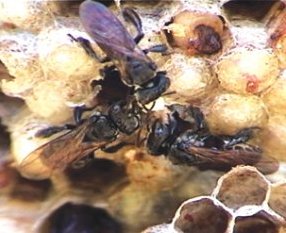A South American bee that ignores flowers and collects the meat from animal carcasses turns out to have an unexpected taste for live prey too.

This stingless bee, Trigona hypogea, carries off the youngsters left behind in newly abandoned wasp nests, says Fernando Noll of the University of São Paulo in Brazil. He and his colleague Sidnei Mateus have observed the bees swiftly cleaning out wasp broods. In an upcoming Naturwissenschaften, the researchers contend that such efficient raiding is “not aberrant behavior, but is merely a lesser known part of the bees’ normal repertoire.”
Most bee species buzz around flowers to collect nectar and pollen. Adults subsist mostly on nectar and save the protein-rich pollen as food for immature bees. Biologists, however, have reported some bees taking advantage of other resources, such as animal droppings and carrion. In 1982, David Roubik, based at the Smithsonian Tropical Research Institute in Ancon, Panama, published a detailed analysis of the lifestyle of a Trigona bee that requires carcasses for its protein. Roubik now lists four species as dedicated meat eaters.
Scoops on the bees’ legs that in other species carry pollen are greatly diminished in these Trigona bees, and their mouthparts end in an unusual toothed edge. Roubik watched foragers in 2 days reduce much of the carcass of a large lizard to a skeleton.
Back at the nest, the bees manage the challenge of storing meat in tropical heat by mixing it with sugary liquids they collect elsewhere—perhaps from fruits, nectar sources outside flowers, or excretions of aphidlike insects. Microbes then break down the mix of chewed-up carrion and syrup into viscous goo, which nourishes the young bees. Says Noll: “It doesn’t taste like dead meat. It’s like flour and honey.”
Since Roubik’s work, says Noll, entomologists have assumed that the species ignore live prey. Noll and Mateus, however, describe three raids on the still-living young of recently abandoned wasp nests. Scout bees found the abandoned nest, and, within 2 hours, 150 bees were pulling out wasp eggs, larvae, and pupae. To harvest the pupae, the bees ripped off the caps of protective cells. The bees filled storage organs in their bodies with the chewed-up material and flew home. After 6 hours, the wasp nest was empty.
Roubik says that he has seen the bees collect toad eggs too. Despite this raiding, he calls the bees scavengers rather than predators. “They just feed off the fat of the forest,” he concludes.






